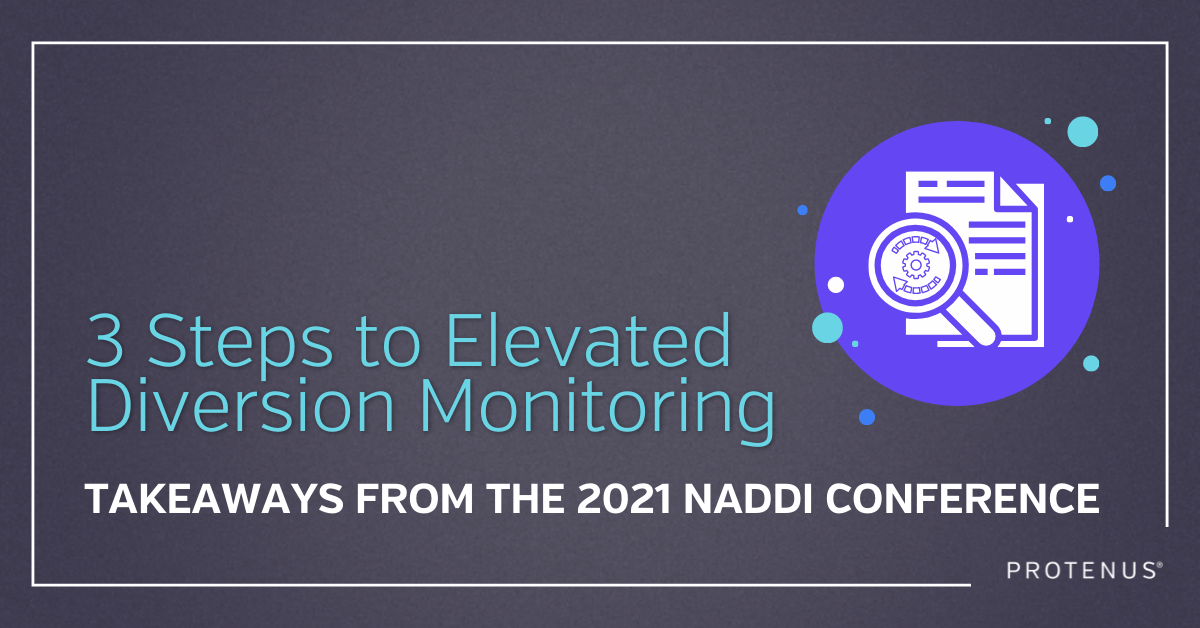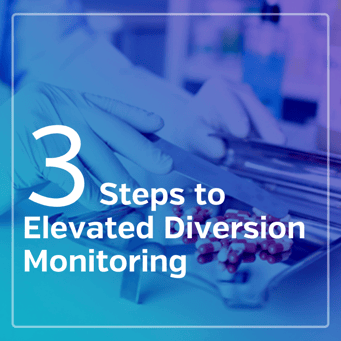Share this

3 Steps to Elevated Diversion Monitoring: Takeaways from the 2021 NADDI conference
by Angie Stewart, Content Specialist, Protenus on November 19, 2021
Automate Diversion Detection to Drastically Reduce Strain
For healthcare organizations across the country, clinical drug diversion monitoring is still in its infancy.

Methods of surveillance have long been limited to reliance on spotty, time-consuming audits that are paper-based or otherwise lacking critical integrations and automation. As a result of tedious, manual, error-prone and inconsistent workflows, diversion investigators are overburdened.
All the while, drug diversion continues under the radar — with severe consequences for patients, employees, and the facilities where it takes place. To successfully establish diversion monitoring programs that can mitigate risks throughout the medication lifecycle, compliance and pharmacy teams can look to what has worked at Ascension, one of the country's largest private healthcare systems. Below we break down the three core steps that Ascension took in their journey toward more efficient diversion monitoring:
1. Communicate risk to decision-makers.
With so many competing priorities on their radar, health system leaders in other departments may not be tuned in to the risks that diversion poses on a daily basis. Individuals whose work centers on preventing and resolving instances of drug diversion can wield these findings to communicate the situation:
- Over 93,000 people died from a drug overdose in 2020 vs. just over 77,000 in 2019, according to the National Institute on Drug Abuse. This amounts to a nearly 30% year-over-year increase in U.S. drug overdose deaths.
- Fentanyl is the driving factor of death due to drug overdose. Fentanyl and other opioids aren't cheap to lose in large quantities, and more importantly, they are extremely dangerous to patients, healthcare workers, and the general public when not used for their intended medical purpose.
- The average fine for a drug diversion incident in 2020 was $585,000 — an amount that could otherwise be put toward direct investment in patient care.
- 77% of all drug diversion detected involves doctors and nurses, the Protenus Diversion Digest shows. Sadly, per the National Institutes of Health, 5 to 10% of healthcare employees work while impaired or under the influence of diverted medications.
Bear in mind that other costs of drug diversion, such as the reputational damage and revenue lost from patients seeking care elsewhere, are not always calculable.
2. Leverage artificial intelligence and automation.
Once stakeholders involved in purchasing decisions fully understand the risks of allowing drug diversion to go undetected, they can realize the massive benefit of investing in sophisticated automated solutions for clinical diversion monitoring.
When Ascension began its vendor selection process, one stand-out feature of Protenus Drug Diversion Surveillance was the ability to detect diversion in instances where other tools couldn't, by pulling in timecard data, EHR data, and ADC data. The platform's integrations and automatic prioritization make it possible to proactively detect the most likely suspicious pharmaceutical transactions and address them before they cause undue harm to patients or increase organizational risk.
With Protenus providing controlled substance monitoring on a single, intuitive platform, health systems are able to work through unlimited cases. Alerts are configurable to surface only those that are most important to each unique organization, so that true violations are detected with exceptional accuracy and efficiency.
3. Fine-tune policies, procedures and processes.
By harnessing AI and automation to proactively identify risky medication handling practices, sprawling health systems can free up time to spend on updating policies and procedures. For instance, if analytics surface a high volume of behaviors that violate medication management policies in a certain way, compliance teams can evaluate procedures and develop awareness campaigns targeting that specific type of misuse.
With Protenus insights, health systems can also determine where there are inefficiencies in incident detection and resolution, then reconfigure workflows accordingly. When working alongside the experts on Protenus' implementation and customer success teams, they don't have to do all the heavy lifting alone; we make ourselves available to share best practices gleaned from years of experience and valuable customer feedback.
Onward with modern monitoring
By enabling health systems to proactively surface and address early warning signs of diversion, Protenus helps free up time and resources for other important efforts to reduce organizational risk.
With a name that translates to onward and upward in Latin, Protenus is proud of the elevated platform we've engineered to address current and future diversion monitoring needs. When your organization is in a position to move toward a proactive monitoring posture, we humbly ask for your consideration — and at any time, don't hesitate to get in touch to see what we're all about.
Share this
- December 1, 2024 (3)
- November 1, 2024 (1)
- October 1, 2024 (2)
- September 1, 2024 (1)
- August 1, 2024 (1)
- July 1, 2024 (1)
- June 1, 2024 (1)
- May 1, 2024 (1)
- March 1, 2024 (2)
- February 1, 2024 (3)
- January 1, 2024 (1)
- December 1, 2023 (1)
- November 1, 2023 (3)
- October 1, 2023 (3)
- September 1, 2023 (1)
- August 1, 2023 (1)
- July 1, 2023 (2)
- April 1, 2023 (1)
- March 1, 2023 (1)
- February 1, 2023 (1)
- December 1, 2022 (3)
- November 1, 2022 (3)
- October 1, 2022 (1)
- September 1, 2022 (1)
- August 1, 2022 (2)
- June 1, 2022 (4)
- May 1, 2022 (5)
- April 1, 2022 (1)
- March 1, 2022 (4)
- February 1, 2022 (3)
- November 1, 2021 (2)
- October 1, 2021 (3)
- September 1, 2021 (3)
- August 1, 2021 (3)
- July 1, 2021 (4)
- June 1, 2021 (2)
- May 1, 2021 (2)
- April 1, 2021 (2)
- March 1, 2021 (5)
- February 1, 2021 (1)
- January 1, 2021 (1)
- December 1, 2020 (1)
- November 1, 2020 (2)
- October 1, 2020 (2)
- September 1, 2020 (3)
- August 1, 2020 (2)
- July 1, 2020 (2)
- June 1, 2020 (6)
- May 1, 2020 (3)
- April 1, 2020 (4)
- March 1, 2020 (2)
- February 1, 2020 (4)
- January 1, 2020 (2)
- December 1, 2019 (2)
- November 1, 2019 (1)
- October 1, 2019 (1)
- September 1, 2019 (1)
- August 1, 2019 (1)
- June 1, 2019 (1)
- April 1, 2019 (1)
- February 1, 2019 (1)
- January 1, 2019 (1)
- December 1, 2018 (2)
- November 1, 2018 (2)
- October 1, 2018 (2)
- September 1, 2018 (3)
- August 1, 2018 (1)
- July 1, 2018 (2)
- June 1, 2018 (2)
- May 1, 2018 (1)
- April 1, 2018 (1)
- March 1, 2018 (2)
- February 1, 2018 (6)
- January 1, 2018 (2)
- September 1, 2017 (2)
- August 1, 2017 (2)
- June 1, 2017 (2)
- May 1, 2017 (1)
- April 1, 2017 (1)
- March 1, 2017 (2)
- February 1, 2017 (5)
- January 1, 2017 (2)
- December 1, 2016 (3)
- November 1, 2016 (5)
- October 1, 2016 (4)
- September 1, 2016 (8)
- August 1, 2016 (4)
- July 1, 2016 (4)
Subscribe by email
You May Also Like

Conserving Resources with Compliance Analytics: A 5-Step Implementation Guide

Enabling Greater Healthcare Efficiency with Protenus AI Technology


